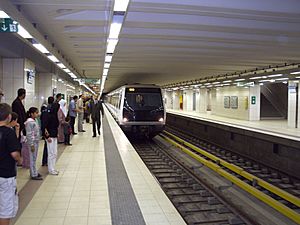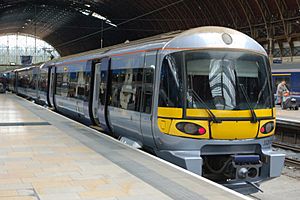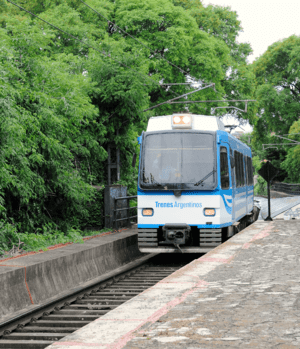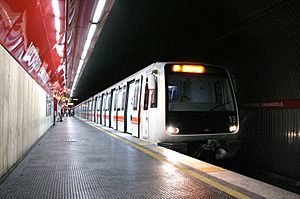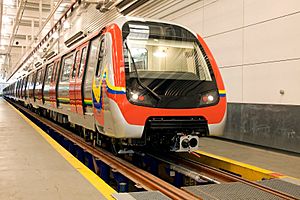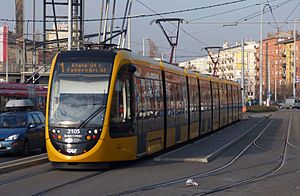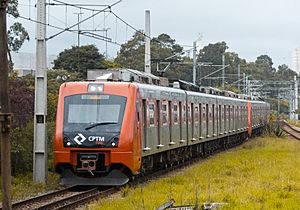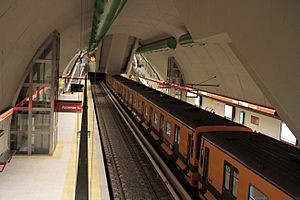Construcciones y Auxiliar de Ferrocarriles facts for kids
 |
|
| Sociedad Anónima | |
| Traded as | BMAD: CAF |
| Industry | Manufacturing |
| Founded | 1917 (Compañía Auxiliar de Ferrocarriles) |
| Headquarters | Beasain, Basque Country, Spain |
|
Number of locations
|
11 factories, including: Beasain (Basque Country) Zaragoza (Aragon) Irún (Basque Country) Linares (Andalusia) Hortolandia (Brazil) Huehuetoca (Mexico) Elmira, New York (US) Bagnères-de-Bigorre (France) Newport, South Wales (UK) |
|
Key people
|
Jose María Baztarrica Garijo, Andrés Arizkorreta (Chief Executive Officer and Chairman) |
| Products | Design, manufacture, maintenance and supply of equipment and components for railway systems |
| Revenue | |
|
Operating income
|
|
| Total assets | |
| Total equity | |
| Owner | Public; Employees via Cartera Social S.A. (25%); Kutxabank (14%) |
|
Number of employees
|
13,284(2021) |
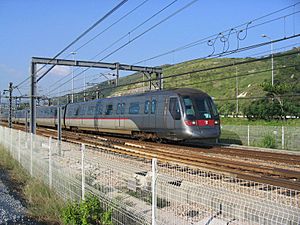
Construcciones y Auxiliar de Ferrocarriles (CAF) is a Spanish company that builds trains, trams, and buses. It is a big name in the railway world. CAF makes many different types of vehicles, from light rail trams to high-speed trains and even locomotives. They also make special parts like axles that can change to fit different track sizes.
CAF is based in Beasain, a town in the Basque Autonomous Community in Spain. Over the past 30 years, CAF has grown a lot. They now supply trains and equipment to cities and countries all over the world. You can find their vehicles in Europe, the US, South America, Asia, Australia, and North Africa.
Contents
How CAF Started
The name CAF comes from an older name, Compañía Auxiliar de Ferrocarriles. It means "Railway Auxiliary Company."
Early Beginnings in Spain
The company's story began in 1860. Three people, Domingo Goitia, Martín Usabiaga, and José Francisco Arana, started a company called Fábrica de Hierros San Martín. They worked with iron, making things like puddling furnaces.
Later, in 1892, Domingo Goitia's son, Francisco de Goitia, teamed up with the Marquess of Urquijo. They created La Maquinista Guipuzcoana. This company focused on building railway vehicles and machinery. In 1898, they opened a factory in Beasain. A few years later, in 1905, its name changed to Fábrica de Vagones de Beasain (FVB), which means "Beasain Wagon Factory."
Becoming Compañía Auxiliar de Ferrocarriles
In 1917, Compañía Auxiliar de Ferrocarriles (CAF) was officially founded. At first, they mainly built freight cars. They had about 1,600 employees.
After the Spanish Civil War, CAF helped rebuild Spain's railway system. In 1940, they opened another factory in Irun. In 1954, CAF joined with another company called Material Móvil y Construcciones (MMC) from Zaragoza. MMC was good at making long-distance and subway trains.
CAF kept growing and modernizing its factories. By 1958, they were making all kinds of railway vehicles. In 1969, CAF started its own Research and Development team. This helped them create new technologies and become more competitive.
CAF Today
In 1971, the two companies, Compañía Auxiliar de Ferrocarriles and Material Móvil y Construcciones, officially merged. They took on the name we know today: Construcciones y Auxiliar de Ferrocarriles.
Since the 1990s, CAF has become a global company. In the early 2000s, they built high-speed trains for Spain's RENFE railway. By 2005, they started exporting high-speed trains to other countries, like Türkiye.
CAF has also bought other companies to expand its business. In 2018, they acquired Solaris, a Polish company that makes buses. In 2022, CAF also took over some train platforms and a factory from other big train manufacturers, Bombardier Transportation and Alstom. This happened because of rules from the European Commission to ensure fair competition.
CAF Around the World
CAF has several important branches in different countries.
CAF in the United States
CAF U.S.A. is a branch of CAF in the United States. It started in 1998 and is based in Elmira, New York. They have a factory in Elmira where they build trains for the North American market. CAF bought this factory in 2000.
CAF in the United Kingdom
CAF Rolling Stock U.K. Ltd. is CAF's branch in the United Kingdom. Their factory is located near Newport, Wales, at Celtic Springs Business Park. This factory was built with help from the Welsh Government.
The Newport factory has built trains for companies like Transport for Wales Rail, Arriva Rail North, and the Docklands Light Railway. CAF also made a donation of £50,000 to the Conservative Party in 2019.
Addressing Challenges with Trains
Like any complex machinery, trains can sometimes have issues. CAF has worked to fix problems that have come up with some of its vehicles.
- In April 2014, in Belgrade, two parts of a tram separated. This was due to screws cracking. CAF worked to fix this issue across the affected trams.
- In March 2016, all 14 British Rail Class 332 trains were taken out of service. A crack was found in the frame of one train during maintenance.
- In December 2017, the Besançon Tramway in Besançon, France, found cracks in their Urbos 3 trams. CAF paid for the repairs, which took about a month for each tram.
- In January 2019, a Bucharest Metro train crashed in a workshop. An investigation showed that the train's software was at fault.
- In April 2021, 22 British Rail Class 195 trains were temporarily removed from service. A part called a yaw damper bracket had come off one train.
- On June 11, 2021, the West Midlands Metro in England had to stop services. Cracks were found in their Urbos 3 trams. Full service started again in February 2022 after repairs.
- On June 24, 2021, Flytoget in Norway had to stop using their new CAF Oaris trains after only 19 days. Cracks were found in the chassis. CAF paid compensation, and most trains were back in service by June 2023.
- In November 2021, the Sydney L1 Dulwich Hill Line in Australia was shut down for a long time. Serious design flaws were found in all 12 of their Urbos 3 trams.
- In March 2022, the West Midlands Metro again had to stop services due to more cracks, this time on the bodywork of the trams.
- In February 2023, it was found that nearly 80 new light rail vehicles for Manila's LRT Line 1 in the Philippines had water leaks. These issues were resolved, and the trains are now in use.
- Also in February 2023, CAF announced a delay for 31 trains for narrow-gauge lines in Spain. The trains were designed too wide to fit through some old tunnels. This will delay delivery by two years.
- In July 2023, cracks were found in four British Rail Mark 5A train sets in the UK. This led to daily checks and some trains being taken out of service. The operator decided to stop using these trains from December 2023.
What CAF Builds
CAF builds a wide variety of railway vehicles for different needs.
Passenger Carriages
CAF makes comfortable carriages for long-distance journeys.
Electric and Diesel Multiple Units (EMU/DMU)
These are trains that can run on electricity (EMU) or diesel (DMU). They are often used for commuter services.
- CAF Oaris
- Civity (used by Sprinter New Generation)
- Civia
- AM class EMU, Auckland
- VR Class Sm4
- Inneo
- Trains for Renfe Operadora (like Class 121, Class 446, 447)
- Trains for Euskotren (like UT200, UT300, UT900, UT950, UT3500)
- Trains for Serveis Ferroviaris de Mallorca (DMU Class 61, EMU Class 71, EMU Class 81)
Locomotives
Locomotives are the engines that pull trains.
- Class 250
- Class 252
- Electro-diesel locomotive Class 1900 (for FEVE)
- BITRAC CC 3600 (Class 601) electro-diesel locomotive
Metro Trains
CAF builds trains for subway systems in many major cities.
- For Madrid: Class 300, 1000, 2000, 3000, 5000, 6000, 8000, 8400
- For Barcelona: Class 1000, 2000, 3000, 4000, 5000, 6000, S/2100, S/300
- For Helsinki: M300
- For Bucharest: BM3
- For Amsterdam: Metromaterieel S3/M4, M7/M8
- For Brussels: Boa
- For Caracas: 60000 series
Trams
CAF is well-known for its Urbos tram series, used in many cities.
- Urbos 1 (Tranvía de Bilbao)
- Urbos 2 (Tranvía de Vélez-Málaga, Tranvía de Vitoria, Metro de Sevilla)
- Urbos 3 (Metrocentro de Sevilla, Tranvía de Zaragoza, Metropolitano de Granada, Tranvía de Vitoria, Metro de Málaga, Tranvía Metropolitano de la Bahía de Cádiz)
Trains and Trams Around the World
CAF trains and trams operate in many countries beyond Spain.
Trains Outside Spain
- Algeria: DMUs
- Argentina: Units for Tren de la Costa
- Australia: New South Wales R sets
- Brazil: CPTM EMUs and São Paulo Metrô
- France: Confort200
- Germany: Commuter train NEXIO for Schönbuch Railway
- Hungary: MÁV vagon
- Ireland: Mark 4 coaches and IE 29000 Class
- Netherlands: Sprinter New Generation
- Norway: SL18
- Portugal: EMUs (UQE´S) for Lisboa
- Saudi Arabia: Diesel Push-Pull Trainsets
- UK: British Rail Mark 5 (Caledonian Sleeper)
- UK: British Rail Mark 5A (used by TransPennine Express until 2023, by Chiltern Railways from 2026)
- UK: British Rail Class 331 (Northern Trains)
- UK: British Rail Class 332 (Heathrow Express)
- UK: British Rail Class 333 (Arriva Trains Northern)
- UK: Class 3000 and Class 4000 (Northern Ireland Railways)
- UK: British Rail Class 397 (TransPennine Express)
- US: Viewliner II (Amtrak)
Metros and Trams Outside Spain
- Algeria: Algiers Metro
- Argentina: Buenos Aires Underground 5000 and 6000 series
- Australia: Light rail in Canberra, Newcastle, and Sydney
- Belgium: Brussels Metro M6 and M7 Series
- Brazil: São Paulo Metro, Cuiabá tram, Recife Metro
- Canada: Calgary Transit Urbos 100 (on order)
- Chile: Santiago Metro
- Colombia: Medellín Metro
- Ecuador: Quito Metro
- Estonia: Tallinn tram
- Finland: Helsinki Metro, M300 series
- France: Nantes Tramway, Besançon Tramway
- Germany: Freiburg tram and Bonn Stadtbahn (on order)
- Hong Kong: Adtranz-CAF EMU (MTR Tung Chung line and Airport Express line)
- Hungary: Trams in Debrecen and Budapest
- India: Delhi Airport Metro Express
- Italy: Bologna tramway, Rome Metro and trams in Rome, Naples Metro
- Luxembourg: Tramway de Luxembourg Urbos 3
- Mauritius: Metro Express Urbos 3
- Mexico: Mexico City Metro (NE-92, NM-02, FE-07, FE-10, NE-16), Mexico City suburban rail, El Insurgente commuter rail
- Netherlands: S3 and M4 units of the Amsterdam Metro, Uithof tram line in Utrecht
- Norway: Oslo trams
- Philippines: Manila LRT Line 1 (LRTA 13000 class), North–South Commuter Railway Airport Express Trains
- Romania: Bucharest Metro Line M2
- Serbia: Belgrade Tram
- Sweden: Stockholm Tram
- Taiwan: Kaohsiung Tram
- Türkiye: Antray (Antalya LRT), M4 (Istanbul Metro)
- UK: DLR B23 stock (Docklands Light Railway), New West Midlands Metro vehicles, Edinburgh Trams
- US: SacRT light rail, Pittsburgh Light Rail, Washington Metro, METRORail (Houston, TX), Kansas City Streetcar, Cincinnati Streetcar, MBTA Green Line Type 9 LRV and Type 10 (on order), MTA Maryland Purple Line (on order)
- Venezuela: Caracas Metro
Images for kids
See also
 In Spanish: Construcciones y Auxiliar de Ferrocarriles para niños
In Spanish: Construcciones y Auxiliar de Ferrocarriles para niños



